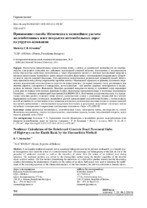Применение способа Жемочкина в нелинейном расчете железобетонных плит покрытия автомобильных дорог на упругом основании
Another Title
Nonlinear Calculation of the Reinforced Concrete Road Pavement Slabs of Highways on the Elastic Basis by the Zhemochkin Method
Bibliographic entry
Кумашов, Р. В. Применение способа Жемочкина в нелинейном расчете железобетонных плит покрытия автомобильных дорог на упругом основании = Nonlinear Calculation of the Reinforced Concrete Road Pavement Slabs of Highways on the Elastic Basis by the Zhemochkin Method / Р. В. Кумашов // Наука и техника. – 2023. – № 2. – С. 158-167.
Abstract
Рассмотрена прямоугольная железобетонная плита с учетом ее физической нелинейности на линейно-упругом однородном основании под действием вертикальной внешней нагрузки. Анизотропия и неоднородность плиты обусловлены свойствами железобетона, а также образованием трещин от действия произвольной нагрузки в процессе эксплуатации. Нелинейную задачу решали способом Жемочкина с использованием итерационного алгоритма метода упругих решений Ильюшина. Для определения коэффициентов разрешающих уравнений способа Жемочкина применяли метод Ритца (определение прогибов плиты с защемленной нормалью) и решение Буссинеска (определение перемещений точек поверхности упругого полупространства). На первой итерации плиту рассчитывали как линейно-упругую, ортотропную и однородную, на последующих – как линейно-упругую, анизотропную и неоднородную на каждом участке Жемочкина. Прогибы срединной поверхности плиты от единичной силы определяли в виде ряда по первым пяти частным решениям Клебша. Выполнены экспериментальные и численные исследования. Последние – с помощью компьютерной программы MATHEMATICA. Полученные результаты показали, что предлагаемая методика расчета позволяет точно описать распределение осадок и реактивных напряжений под плитой. Верификацию методики статического нелинейного расчета прямоугольной железобетонной плиты с учетом ее физической нелинейности осуществляли путем сравнения результатов расчетов максимальных осадок и средних давлений под плитой, вычисленных с использованием предлагаемой методики, и результатов, полученных с помощью метода послойного суммирования и современных программных комплексов «Лира» и PLAXIS 3D.
Abstract in another language
A rectangular reinforced concrete slab is considered taking into account its physical nonlinearity on a linearly elastic homogeneous base under the action of a vertical external load. The anisotropy and heterogeneity of the slab are due to the properties of reinforced concrete, as well as the formation of cracks from the action of an arbitrary load during operation. The nonlinear problem was solved by the Zhemochkin method using the iterative algorithm of the Ilyushin elastic solution method. The Ritz method (determining the deflections of a slab with a pinched normal) and the Boussinesq solution (determining the displacements of points on the surface of an elastic half-space) were used to determine the coefficients of the resolving equations of the Zhemochkin method. At the first iteration, the slab was calculated as linearly elastic, orthotropic, and homogeneous; at subsequent iterations, it was calculated as linearly elastic, anisotropic, and inhomogeneous at each Zhemochkin site. The deflections of the middle surface of the slab from a unit force were determined as a series according to the first five particular Clebsch solutions. Experimental and numerical researches have been carried out. The latter – with the help of the MATHEMATICA computer program. The results obtained showed that the proposed calculation method allows one to accurately describe the distribution of settlements and reactive stresses under the slab. Verification of the methodology for static nonlinear calculation of a rectangular reinforced concrete slab, taking into account its physical nonlinearity, was carried out by comparing the results of calculations of maximum settlement and average pressures under the slab, obtained using the proposed methodology, and the results obtained using the layer-by-layer summation method and modern software systems Lira and PLAXIS 3D.
View/
Collections
- № 2[11]

